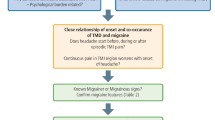Abstract
It has been estimated that 30% to 80% of the population has at least one tension-type headache each year. Tensiontype headaches can be located in any region of the head, which can confuse a differential diagnosis with temporomandibular joint disorders and cervical dysfunction. The roles of temporomandibular joint disorders and cervical dysfunction in tension-type headache are evaluated. Definitions, pathophysiology, and treatment considerations for each are discussed.
Similar content being viewed by others
References and Recommended Reading
Schade AJ: Quantitative assessment of the tension-type headache and migraine severity continuum. Headache 1997, 37(10):646–653.
Ulrich V, Russell MB, Jensen R, Olesen J: A comparison of tension-type headache in migraineurs and in non-migraineurs: a population-based study. Pain 1996, 67(2-3):501–506.
Headache Classification Committee of the International Headache Society: Classification and diagnostic criteria for headache disorders, cranial neuralgias, and facial pain. Cephalalgia 1988, 8(suppl 7):1–96.
The Headaches edn 2. Epidemiology of tension-type headache. Edited by Olesen J, Tfelt-Hansen P, Welch, KM. Philadelphia: Lippincott, Williams & Wilkins; 2000:545–550.
Schwartz BS, Stewart WF, Simon DD, Lipton RB: Epidemiology of Tension-type Headache. JAMA 1998, 279:381–383.
Gobel H, Peterson-Braun M, Soyka D: The epidemiology of headache in Germany: a nationwide survey of a representative sample on the basis of the headache classification of the International Headache Society. Cephalalgia 1994, 14:97–106.
Olesen J, Langemark M: Mechanisms of tension headache: a speculative hypothesis. In Basic Mechanism of Headache. Edited by Olesen J, Eldvinsson L. Amsterdam: Elsevier; 1988:457–461.
Jensen R: Pathophysiologic mechanisms of tension-type headache: a review of epidemiological and experimental studies. Cephalalgia 1999, 19(6):602–621.
Langemark M, Olesen J: Pericranial tenderness in tension headache: a blinded, controlled study. Cephalalgia 1987, 7(4):249–55.
Nelson CF: The tension headache, migraine headache continuum: a hypothesis. J Manipulative Physiol Ther 1994, 17(3):156–167.
Tajti J, Uddman R, Edvinsson L: Neuropeptide localization in the “migraine generator” region of the human brainstem. Cephalalgia 2001, 21(2):96–101.
Welch KM, Nagesh V, Aurora SK, Gelman N: Periaqueductal gray matter dysfunction in migraine: cause or the burden of illness? Headache 2001, 41(7):629–637. This is an important article because it shows the potential for changes that take place in the brain secondary to pain. These changes may be the cause of chronic illness and persistent pain.
Kellgren JH: Observations on referred pain arising from muscle. Clin Sci 1938, 3:175–190.
Mense S: Referral of muscle pain new aspects. Pain Forum 1994, 3(1):1–9.
Mense S: Considerations concerning the neurobiologic basis of muscle pain. Canad J Physiol Pharm 1991, 9:610–616.
Mense S: Nociception from skeletal muscle in relation to clinical muscle pain. Pain 1993, 54:241–289.
Simons DG: Neurophysiologic basis of pain caused by trigger points. APS Journal 1994, 3(1):17–19.
Pedersen-Bjergaard U, Nielsen LB, Jensen K, et al.: Calcitonin gene-related peptide, neurokinin A, and substance P: effects on nociception and neurogenic inflammation in human skin and temporal muscle. Peptides 1991, 12:333–337.
Fields HL, Heinricher M: Brainstem modulation of nociceptor-driven withdrawal reflexes. Ann NY Acad Sci 1989, 563:34–44.
Piovesan EJ, Kowacs PA, Tatsui CE, et al.: Referred pain after painful stimulation of the greater occipital nerve in humans: evidence of convergence of cervical afferences on trigeminal nuclei. Cephalalgia 2001, 21(2):107–109. In this article, there is evidence provided for a link between neck pain and the trigeminal neural system. This concept is essential to understanding and treating headache and facial pain.
Bendtsen L: Central sensitization in tension-type headache: possible pathophysiologic mechanisms. Cephalalgia 2000, 20(5):486–508. This is an important article because it considers the possibility that tension-type headaches may be a central phenomena.
International Association for the Study of Pain Subcommittee on Taxonomy: Classification of chronic pain: descriptions of chronic pain syndromes and definitions of pain terms. Pain 1986, 3:S1-S225.
Travell JG, Simons DG: Myofascial pain and dysfunction. In The Trigger Point Manual. Baltimore: Williams & Wilkins; 1983:5–44.
Simons DG: Muscle pain syndromes: part I. Am J Phys Med 1975, 54(6):289–311.
Simons DG: Muscle pain syndromes: part II. Ame J Phys Med 1976, 55(1):15–42.
Travell JG: Myofascial trigger points: clinical view. In Advances in Pain Research and Therapy. Edited by Bonica JJ, Albe-Fessard D. New York: Raven Press; 1976:919–926.
Kellgren JH: Observations on referred pain arising from muscle. Clin Sci 1938, 3:175–190.
Simons DG: Neurophysiologic basis of pain caused by trigger points. APS Journal 1994, 3(1):17–19.
Fields HL, Heinricher M: Brainstem modulation of nociceptor-driven withdrawal reflexes. Ann NY Acad Sci 1989, 563:34–44.
Olesen J: Clinical and pathophysiologic observations in migraine and tension-type headache explained by integration of vascular, supraspinal, and myofascial inputs. Pain 1991, 46(2):125–132.
Ernberg M, Hadenberg-Magnusson B, Alstergren P, et al.: Pain, allodynia, and serum serotonin level in orofacial pain of muscular origin. J Orofacial Pain 1999, 13:56–62.
Bendtsen L: Central sensitization in tension-type headache: possible pathophysiologic mechanisms. Cephalalgia 2000, 20(5):486–508.
Bendtsen L, Jensen R: Amitriptyline reduces myofascial tenderness in patients with chronic tension-type headache. Cephalalgia 2000, 20(6):603–610.
Sjaastad O, Saunte C, Hovdahl H, et al.: Cervicogenic headache: a hypothesis. Cephalalgia 1983, 3(4):249–256.
Sjaastad O, Fredriksen TA, Pfaffenrath V: Cervicogenic headache: diagnostic criteria. Headache 1990, 30(11):725–726.
Vincent MB, Luna RA: Cervicogenic headache: a comparison with migraine and tension-type headache. Cephalalgia 1999, 19(suppl 25):11–16.
Leone M, D’Amico D, Grazzi L, et al.: Cervicogenic headache: a critical review of the current diagnostic criteria. Pain 1998, 78(1):1–5.
Aprill C, Axinn MJ, Bogduk N: Occipital headaches stemming from the lateral atlanto-axial (C1-C2) joint. Cephalalgia 2002, 22:15–22. This article reviews a study that used a cervical joint block to treat and diagnose cervicogenic headaches. It shows that more research needs to be done to find the exact meaning of cervicogenic headache.
Author information
Authors and Affiliations
Rights and permissions
About this article
Cite this article
Graff-Radford, S.B., Newman, A.C. The role of temporomandibular disorders and cervical dysfunction in tension-type headache. Current Science Inc 6, 387–391 (2002). https://doi.org/10.1007/s11916-002-0081-y
Issue Date:
DOI: https://doi.org/10.1007/s11916-002-0081-y




